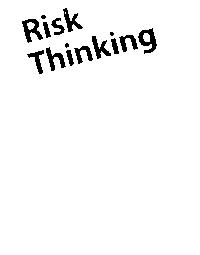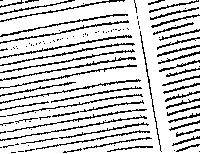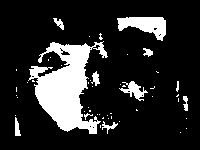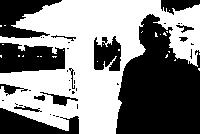
Mark Melnicove at his exhibit, Word Art, on the second floor of Hawthorne-Longfellow Library
The poems, collages, books, letters, newspapers, zines, prints, photographs, cut-out poems, broadsides, audio, and video currently displayed in the 2nd floor exhibit space of the Hawthorne-Longfellow Library offer a glimpse into almost five decades of artist and writer Mark Melnicove’s creative output. The show’s reach also extends to Melnicove’s many collaborations with other Maine-based artists.
Melnicove, who curated the new library exhibit Word Art Collaborations, is quick, however, to correct the impression that the show only offers a survey of part of Maine’s art and literary history roughly from the late 1970s to today. Instead, he offers an alternative reading of the collection, which has strong environmental and social undercurrents. “For me, the show is about the future, not the past,” he said. “Unfortunately, the problems of the past haven’t gone away.”
Word Art Collaborations, which will have an opening reception October 1 and run through the semester, contains a sampling from Melnicove’s large archive, which the Bowdoin Library’s George J. Mitchell Department of Special Collections & Archives acquired between 2007 and 2015. Richard Lindemann, the former director of Special Collections, worked with Melnicove to secure his papers because they offered a valuable “perspective on visual poetry, small press publishing, and Maine’s literary and art history.” Lindemann added that Melnicove, “while centered in Maine,…enjoyed wide contacts with important contemporary American poets, particularly those who have explored new approaches to writing poetry.”
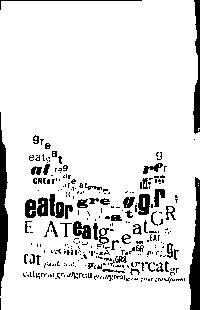
Mark Melnicove, “greatgreatgreatgreat…grandparents,” Princeton, N.J., 1973, Letterpress, concrete poem
Over the past 40 years, Melnicove has not only created a vast quantity of his own work, but he has also supported many Maine writers, artists and poets. He was director of the Maine Writers & Publishers Alliance from 1980-82, and then from 1986-88, and in 1979 he founded The Dog Ear Press, which focused on publishing Maine works. Since 2002, he has taught English and creative writing at Falmouth High School.
Many of the pieces displayed in Word Art Collaborations treat words and letters in playful and provocative ways. Word art, according to Melnicove, uses a page’s dimensions, space, typography and design to convey meaning. Some of the poems in the exhibit can be read diagonally or vertically; others reveal hidden messages upon close scrutiny.
The show is organized in chapters, 1 through 21, which are more thematic than chronological. Some of the work is solely Melnicove’s, some is collaborative work, and some other artists’ pieces. Over his career, Melnicove has worked with important Maine and New England-based writers and artists, including Bern Porter, Carlo Pittore, Lee Sharkey, Grace Paley, Edgar Allen Beem, Robert Shetterly, and Helen Nearing.
Melnicove arrived in Maine in 1977 four years after graduating from Princeton University. At the time, he was focused on using letterpress printing to make art out of poetry. “This opened up the compositional field to a lot of different ways of reading,” he said. In the first glass case, you can see his artistic interpretations of poems by W.S. Merwin and Donald Justice.
But Melnicove’s word play is not limited to letters typed or written on the page. One of the exhibit’s chapters contains what Melnicove calls photoglyphs, or photographs with words or “wordly elements.” One of these is a cropped photograph of a common sign found at local grocery stores that, in Melnicove’s rendering, reads like a stark censorship warning.
Another chapter in the show is based on mail art, or correspondence art, terms that refer to a democratic way of collecting and displaying art and poetry. A mail art show begins when a curator an artist identifies a theme and puts out a call for submissions. Artists and writers from around the world send in work through the mail. Everything is included in the show. “It’s a rebellion against the exclusivity of the gallery and museum system,” Melnicove said.
A section in the exhibit is dedicated to books, many of them children’s books, such as Margy Burns Knight and Anne Sibley O’Brien’s still timely take on immigration, Who Belongs Here? (1993), and Mary Beth Owens’ A Caribou Alphabet, which was published at the time (1988) Maine was trying (unsuccessfully) to reintroduce caribou to the state.
The final chapter in the exhibit is dedicated to Melnicove’s current students at Falmouth High School. It displays objects such as drawings, poetry, a film poster, and covers of the school’s creative writing magazine. “Where the show ends or begins is with the students,” Melnicove said. “They’re our hope for the future.”
Reception and conversation with Mark Melnicove will be held Thursday, October 1, 5:00-7:00pm, second floor, Hawthorne-Longfellow Library. It will be free and open to the public.
Word Art Collaborations is on view until December 23, 2015.
